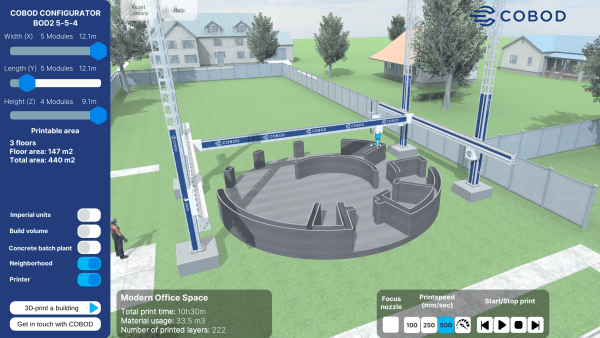COBOD has just made the life of contractors and real estate developers much easier. With the release of a 3D construction printer configurator, the construction 3D printing company gives professionals the ability to estimate the exact printing time and amount of concrete materials needed to build a specific building. This means for instance, the configurator shows layer by layer how the printer can build a 170 m² (1.900 square feet) villa in just 26 hours.
Described as the first live and 3D visualized configurator to create 3D construction printers, this new solution is available as an app for Android and iOS devices and as a web app edition.
“With this tool, you can configure the size of our modular printers up to 3 story building printers, simulate the print time and material consumption for our use case buildings. Using the configurator, you can see what the printer exactly looks like and what it can do for you” Henrik Lund-Nielsen, Founder & General Manager of COBOD International, said.
Users of COBOD’s new configurator can start by configuring their 3D printer, modifying the printer width, length, and height. The configurator also makes it possible to calculate the time it takes to print out a specific structure and calculate the quantity of materials needed, a press release reads.
According to the consulting company McKinsey , there is a potential for doubling productivity in the construction industry by realizing the automation potential. A potential that has made the global construction industry keenly aware of how robotic 3D printers will become standard equipment at the construction sites of tomorrow.
This trend is reflected in orders for COBOD’s 3D construction printers; In 2021 revenue skyrocketed, tripling the revenue generated in 2020, already twice that of 2019.
“3D-printed buildings have now become a more advantageous option than conventional building methods. This is because a 3D printer saves many resources compared to conventional methods: It goes faster, requires fewer construction workers that are so hard to find these days and makes the working environment healthier. With our new Dfab solution for making 3D printable real concrete, locally sourced materials can be used to minimise the cost, transport, and delivery time as well” says the COBOD founder Henrik Lund-Nielsen.
Remember, you can post job opportunities in the AM Industry on 3D ADEPT Media free of charge or look for a job via our job board. Make sure to follow us on our social networks and subscribe to our weekly newsletter : Facebook, Twitter, LinkedIn & Instagram ! If you want to be featured in the next issue of our digital magazine or if you hear a story that needs to be heard, make sure to send it to contact@3dadept.com






